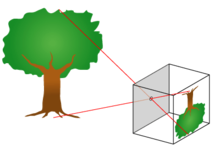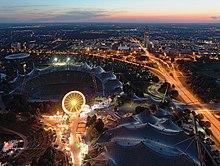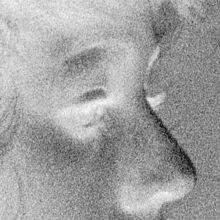Science of photography
A simple example is the three-element Cooke triplet, still in use over a century after it was first designed, but many current photographic lenses are much more complex.
They can also be reduced dramatically by using an aspheric element, but these are more complex to grind than spherical or cylindrical lenses.
[3] The recently developed Fiber-coupled monocentric lens consists of spheres constructed of concentric hemispherical shells of different glasses tied to the focal plane by bundles of optical fibers.
[4] Monocentric lenses are also not used in cameras because the technology was just debuted in October 2013 at the Frontiers in Optics Conference in Orlando, Florida.
Chromatic aberration is caused by a lens having a different refractive index for different wavelengths of light and the dependence of the optical properties on color.
Focus is the tendency for light rays to reach the same place on the image sensor or film, independent of where they pass through the lens.
The finite spot size caused by diffraction can also be expressed as a criterion for distinguishing distant objects: two distant point sources can only produce separate images on the film or sensor if their angular separation exceeds the wavelength of light divided by the width of the open aperture of the camera lens.
As such, films and printing papers available for analog photography rarely rely on any other chemical process to record an image.
The latter made the dry form unsuitable for the usual portraiture work of most professional photographers of the 19th century.
The use of the dry form was therefore mostly confined to landscape photography and other special applications where minutes-long exposure times were tolerable.
Gum bichromate is a 19th-century photographic printing process based on the light sensitivity of dichromates.
[10] They are composed of three layers of gelatin, each containing an emulsion of silver halide, which is used as a light-sensitive material, and a different dye coupler of subtractive color which together, when developed, form a full-color image.
It does so by converting the variable attenuation of light waves (as they pass through or reflect off objects) into signals, small bursts of current that convey the information.
The law of reciprocity describes how light intensity and duration trade off to make an exposure—it defines the relationship between shutter speed and aperture, for a given total exposure.
Light is most easily controlled through the use of the camera's aperture (measure in f-stops), but it can also be regulated by adjusting the shutter speed.
This causes a distinctive streaky appearance to the moving object or the entire picture (in the case of camera shake).
Photographs of the lines of light visible in long exposure photos of roads at night are one example of the effect.
At longer focal lengths, the same movement of the camera body will cause more motion of the image, so a shorter shutter time is needed.
A commonly cited rule of thumb is that the shutter speed in seconds should be about the reciprocal of the 35 mm equivalent focal length of the lens in millimeters.
Motion blur due to subject movement can usually be prevented by using a faster shutter speed.
These crystals contain silver grains that determine how sensitive the film is to light exposure, and how fine or grainy the negative the print will look.
Photodiodes are back-biased semiconductor diodes, in which an intrinsic layer with very few charge carriers prevents electric currents from flowing.
The electron and the "hole", or the empty space where it was, are then free to move in the electric field and carry current, which can be measured.
The fraction of incident photons that produce carrier pairs depends largely on the semiconductor material.
Photomultiplier tubes are vacuum phototubes that amplify light by accelerating the photoelectrons to knock more electrons free from a series of electrodes.
Some digital cameras and scanners have anti-aliasing filters to reduce aliasing by intentionally blurring the image to match the sampling rate.
It is usually desirable to suppress both noises such as grain and details of the real object that are too small to be represented at the sampling rate.





